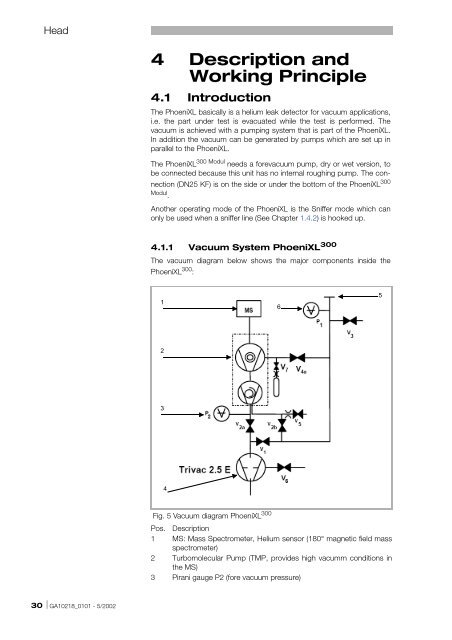Manual - Leybold Repair by Tech Services
Manual - Leybold Repair by Tech Services
Manual - Leybold Repair by Tech Services
You also want an ePaper? Increase the reach of your titles
YUMPU automatically turns print PDFs into web optimized ePapers that Google loves.
Head<br />
30 ⏐GA10218_0101 - 5/2002<br />
4 Description and<br />
Working Principle<br />
4.1 Introduction<br />
The PhoeniXL basically is a helium leak detector for vacuum applications,<br />
i.e. the part under test is evacuated while the test is performed. The<br />
vacuum is achieved with a pumping system that is part of the PhoeniXL.<br />
In addition the vacuum can be generated <strong>by</strong> pumps which are set up in<br />
parallel to the PhoeniXL.<br />
The PhoeniXL300 Modul needs a forevacuum pump, dry or wet version, to<br />
be connected because this unit has no internal roughing pump. The connection<br />
(DN25 KF) is on the side or under the bottom of the PhoeniXL 300<br />
Modul .<br />
Another operating mode of the PhoeniXL is the Sniffer mode which can<br />
only be used when a sniffer line (See Chapter 1.4.2) is hooked up.<br />
4.1.1 Vacuum System PhoeniXL 300<br />
The vacuum diagram below shows the major components inside the<br />
PhoeniXL 300 :<br />
1<br />
2<br />
3<br />
4<br />
Fig. 5 Vacuum diagram PhoeniXL 300<br />
Pos. Description<br />
1 MS: Mass Spectrometer, Helium sensor (180° magnetic field mass<br />
spectrometer)<br />
2 Turbomolecular Pump (TMP, provides high vacumm conditions in<br />
the MS)<br />
3 Pirani gauge P2 (fore vacuum pressure)<br />
6<br />
5


